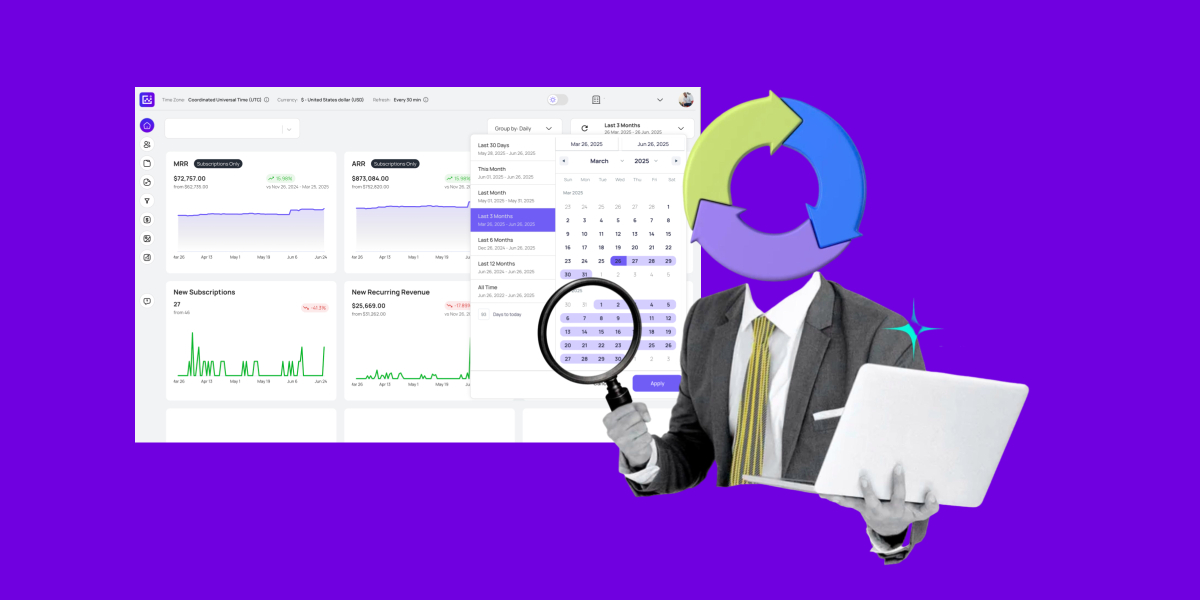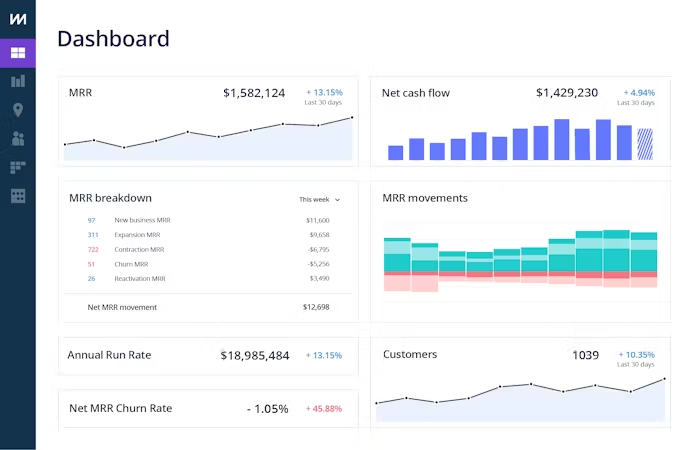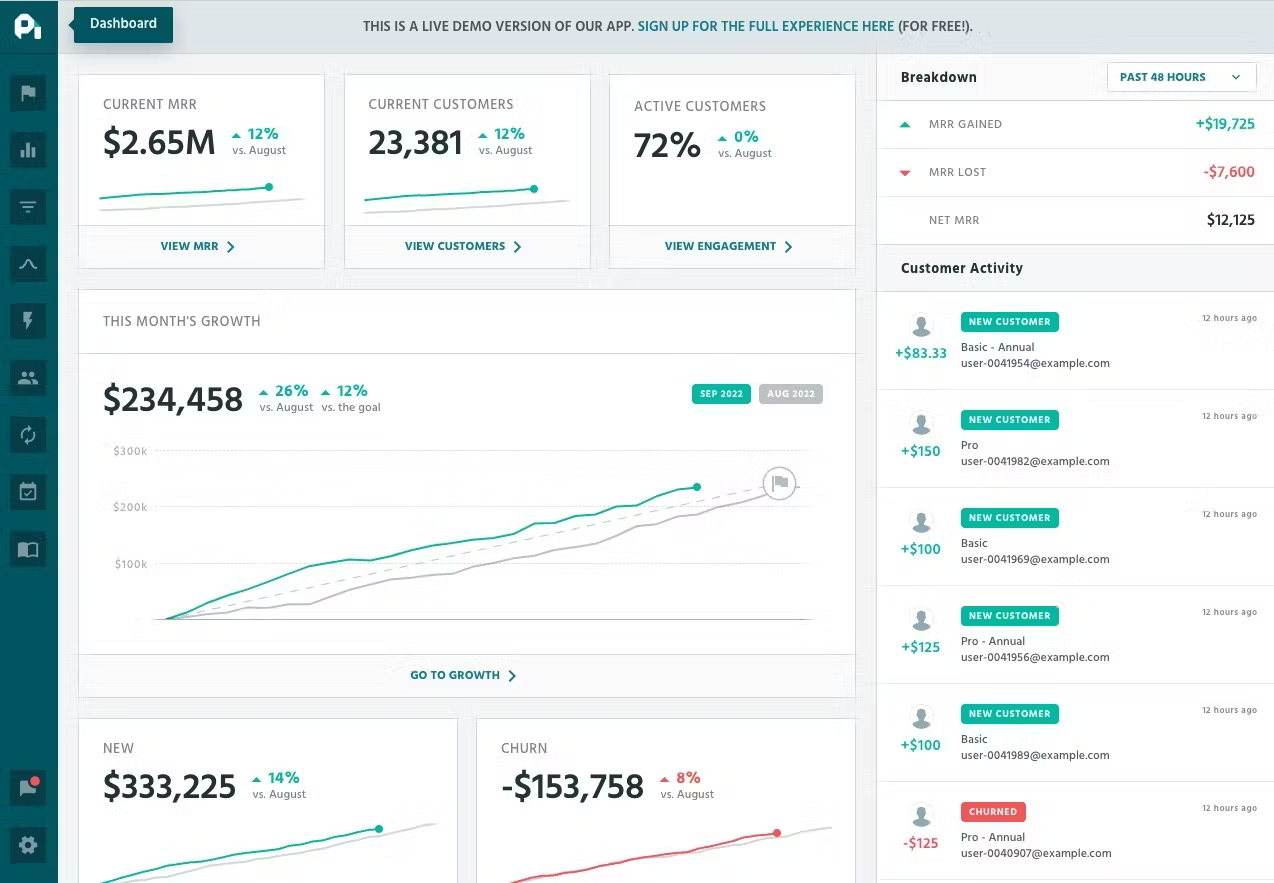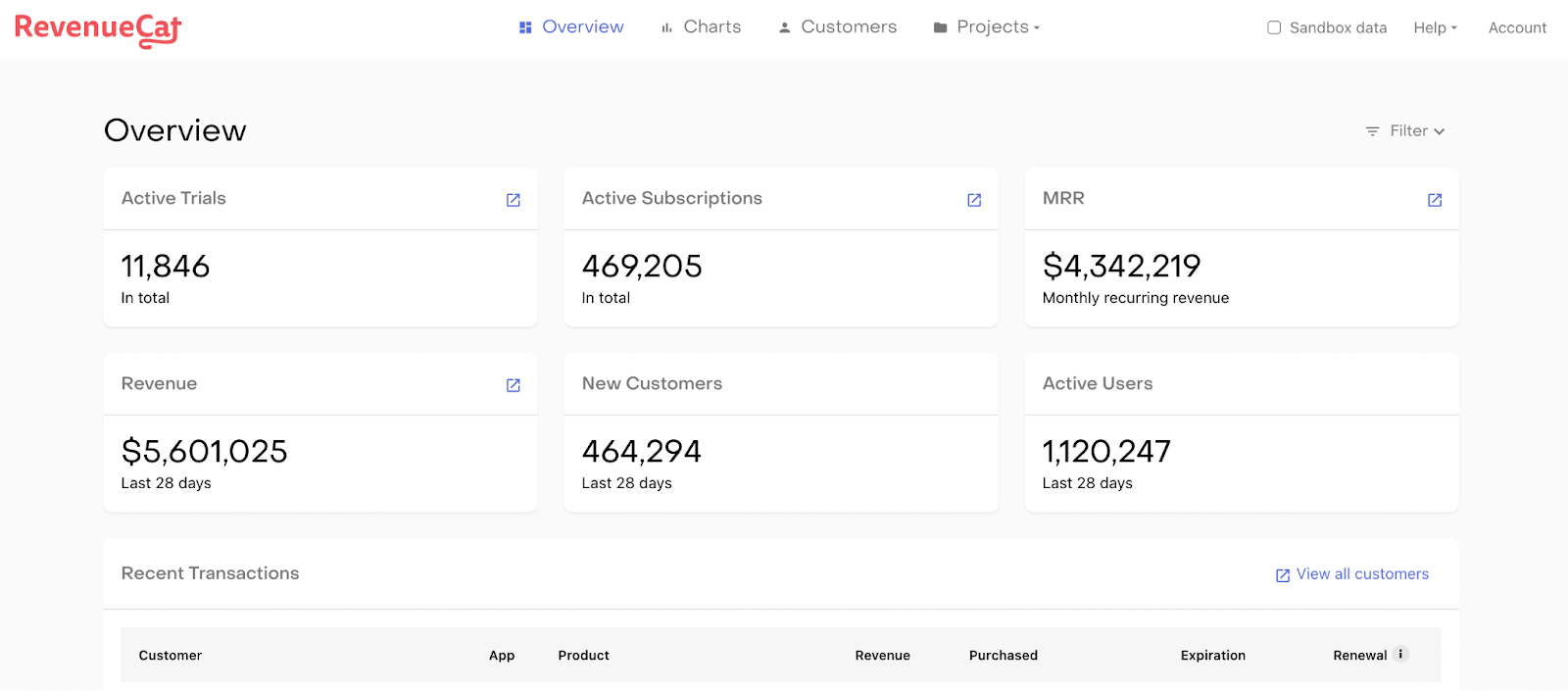August 30, 2025
6 Best Subscription Analytics Tools for Growing SaaS Businesses

August 30, 2025

Your monthly recurring revenue just dropped 15%. You have no idea why. Three of your biggest customers churned last week, but your payment processor only shows "card declined" as the reason.
Meanwhile, you're burning through cash while celebrating vanity metrics like total signups. But do those signups actually predict whether you'll make payroll next month?
You're not alone in this. According to Recurly's 2025 State of Subscriptions report, acquisition rates have fallen from 4.1% in 2021 to 2.8% in 2024, which makes retention more critical than ever. The report, which analyzes data from 67 million subscribers across 2,200+ merchants and was released January 2025, shows that companies with poor churn visibility struggle to understand why customers leave, which makes it harder to prevent future losses.
When you run a subscription business without proper analytics, you're performing surgery blindfolded. You might get lucky, but eventually, you're going to hit something vital.
This guide shows you exactly which tools you should consider to track what actually matters. How much they cost. Which one fits your specific situation. More importantly, you'll learn how to implement these tools to catch problems before they kill your business.
You're probably making the same critical mistake most businesses make. You try to measure subscription success with tools designed for one-time transactions. This fundamental mismatch creates blind spots that can kill your business before you realize what's happening.
Take Google Analytics. It tracks your website visitors beautifully, but it only remembers customers for 90 days. It treats each subscription payment like a separate purchase.
When a customer pays you $99/month for eight months, Google Analytics sees eight individual $99 transactions. Not one $792 lifetime value customer. This fundamental misunderstanding leads to decisions that feel right but slowly kill your business.
Here's what probably happened to you or will happen soon. You're celebrating because Google Analytics shows consistent month-over-month transaction growth. New customers are signing up. Existing customers are making payments. Everything looks healthy.
Then you implement proper subscription analytics and discover your business is actually bleeding money. Your customer acquisition cost might be $180, but your average customer lifetime value is only $127. Every new customer is making you poorer. But your generic analytics make it look like growth.
You've probably felt like your numbers look good on paper but something still feels off.
Subscription analytics tools solve this by tracking the entire customer lifecycle. They understand that Sarah from accounting signed up in January. She upgraded to the pro plan in March. Downgraded in June. Churned in September.
They calculate her true lifetime value ($547). Show you the upgrade trigger (new team member). Identify the downgrade warning sign (usage dropped 40%). Flag similar patterns in your other customers before they churn.
The difference between traditional and subscription analytics goes beyond technical capabilities. Traditional analytics answer "what happened?" while subscription analytics answer "what's going to happen?" and "how can we influence it?"
Before you dive into specific tools, you need to understand which metrics separate thriving subscription businesses from failing ones. You probably track dozens of numbers. But only five actually predict whether you'll survive the next 12 months.
Master these. Ignore everything else until you have them dialed in.
MRR isn't just your predictable monthly income. It's four different revenue streams that tell completely different stories about your business health. Understanding each component can save your business from slow-motion failure.
New MRR comes from first-time customers. If this number isn't growing consistently, you have an acquisition problem. That will eventually kill growth.
Expansion MRR comes from existing customers paying you more. Through upgrades, add-ons, or increased usage. High-growth SaaS companies rely heavily on expansion revenue from their existing customer base, which makes this a critical metric for sustainable growth.
Contraction MRR represents customers paying you less through downgrades. Some contraction is normal. But if it's accelerating, customers aren't getting enough value from higher-tier plans.
Churned MRR is revenue lost from cancellations. Track this weekly, not monthly. Problems compound quickly.
The good part happens when you track these together. Healthy businesses see expansion MRR offset 40-50% of churned MRR. This creates net revenue growth even when new customer acquisition slows down.
You probably obsess over customer churn rate (percentage of customers who cancel). But revenue churn rate often matters more for business survival. This distinction can mean the difference between panicking over healthy business dynamics and missing real problems until they're unfixable.
Here's why this matters for you. If you lose ten $10/month customers but retain one $200/month customer, your customer churn looks terrible (91%). But your revenue churn is actually manageable (33%).
Customer churn tells you about satisfaction and product-market fit. Revenue churn tells you about cash flow and growth sustainability.
For context, if you're under $10M ARR, you'll typically see 3-7% monthly customer churn, though B2B SaaS businesses often achieve lower rates (2-4%) while B2C subscription services may see higher rates depending on their market segment. If you're a larger company, you can achieve 1-2% monthly churn rates. But your revenue churn should always be lower than customer churn if you're attracting higher-value customers over time.
When your revenue churn exceeds customer churn, you're losing your best customers. That's a death spiral that's hard to recover from.
This ratio determines whether your business model works mathematically. But you probably calculate it wrong. This leads to decisions that slowly bankrupt your company even when growth looks healthy on the surface.
Calculate CLV as: Average Revenue Per User × Gross Margin % ÷ Monthly Churn Rate. Calculate CAC as: Total Sales & Marketing Spend ÷ Number of New Customers Acquired.
Your CLV:CAC ratio should be at least 3:1 for a healthy business. But here's the critical part you probably miss. You need to recover your CAC within 12 months for cash flow to work.
A CLV:CAC ratio of 6:1 sounds great until you realize it takes 36 months to recover acquisition costs. Which means you're essentially giving customers a three-year loan while burning through your bank account.
This metric combines expansion, contraction, and churn into one number. It predicts long-term success better than any other measurement.
NRR above 100% means your existing customers are generating more revenue over time. Even without acquiring new ones. Companies with NRR above 120% grow exponentially. Those below 90% struggle to survive.
Calculate it as: (Starting MRR + Expansion MRR - Contraction MRR - Churned MRR) ÷ Starting MRR × 100.
NRR reveals whether you have a growth engine or a leaky bucket. Businesses with high NRR can survive acquisition challenges, economic downturns, and competitive pressure. Their existing customer base generates compound growth.
Low NRR businesses live and die by new customer acquisition. This makes them vulnerable to any disruption in their marketing channels.
Time to value measures how long your customers take to achieve their first meaningful outcome with your product. This metric predicts long-term retention better than any other early indicator. It's crucial for preventing churn before it happens.
Customers who reach activation quickly have significantly higher retention rates than those who take longer to see value, according to growth studies from leading SaaS companies. The faster your customers achieve their first meaningful outcome, the more likely they are to remain subscribers long-term.
Define activation based on your specific product. If you run project management software, it might be creating the first project and inviting team members. If you have analytics tools, it could be connecting a data source and viewing the first report.
Track activation rates by customer segment, acquisition channel, and signup method. Your customers from different sources often have dramatically different activation patterns. This reveals which marketing channels attract engaged users versus tire-kickers.
The subscription analytics market has matured significantly. Clear winners have emerged in different categories. Rather than trying to be everything to everyone, the best tools now focus on specific strengths that solve particular business challenges.
Understanding these strengths helps you choose the right tool for your situation. Instead of paying for features you'll never use.

GrowthOptix represents a new approach to subscription analytics. They combine traditional metrics with growth intelligence to help you make smarter decisions about where to focus your limited resources.
What makes GrowthOptix different for your business
GrowthOptix focuses specifically on your needs as a bootstrapped and early-stage subscription business. Their platform integrates subscription analytics with growth experimentation tools. Customer feedback collection. Competitive intelligence. All designed to help small teams prioritize the right growth levers.
Their unique approach includes automated growth experiments that test pricing, onboarding flows, and retention strategies. Built-in customer interview scheduling and feedback analysis. Competitive tracking that shows how your metrics compare to similar businesses in real-time.
Best for you if: You're an ecommerce, B2C, B2B startup that needs more than just analytics. You want actionable growth recommendations based on your specific situation and constraints.
Pricing: Contact for pricing as they offer flexible packages designed for different growth stages and budget constraints.
Why this matters for you: GrowthOptix understands that you can't implement every optimization at once. Their platform helps you prioritize which improvements will have the biggest impact on your specific business model and situation.

ChartMogul earned its reputation by solving the data accuracy problem that plagues most analytics platforms. When you're making critical business decisions based on metrics, or preparing for investor due diligence, accuracy isn't negotiable. It's survival.
What makes ChartMogul different from the competition
ChartMogul connects to 25+ billing platforms and automatically cleans your data. It uses sophisticated algorithms that handle edge cases other tools miss. It processes refunds, prorations, currency conversions, and billing anomalies that break most analytics setups.
More importantly, it provides benchmarking data from 2,500+ similar companies. So you can see if your 5% monthly churn rate is actually good or terrible for your industry and size.
Their 2025 enhancements include predictive churn modeling with 90%+ accuracy. False churn detection that identifies temporary payment failures versus true cancellations. The mobile app allows you to monitor critical metrics during investor meetings or while traveling. With the same data accuracy you get from the desktop platform.
Best for you if: You run a B2B SaaS company that needs investor-grade reporting accuracy. You want comprehensive benchmarking against similar businesses. You need bulletproof data integrity for board meetings and fundraising.
Pricing: Free up to $10K MRR, then starting around $100/month with pricing scaling based on revenue. Contact ChartMogul for exact pricing tiers as rates vary by specific ARR levels. The free tier includes core MRR tracking, basic segmentation, and essential reports. Enough for most early-stage companies to establish baseline metrics.
What you might experience: If you're like most founders, you'll discover that customers from organic search have 40% higher lifetime value than paid acquisition. This insight alone can completely change your marketing spend allocation and improve your unit economics by 60%.

If ChartMogul focuses on data accuracy, Baremetrics excels at actionable insights. These directly impact your bottom line within days of implementation. Their approach combines analytics with automated revenue optimization tools. The results often pay for the entire platform within the first month.
What makes Baremetrics special beyond basic analytics
Recover automatically retries failed payments using smart algorithms. It optimizes retry timing, payment methods, and customer communication. It can recover 10-15% of failed charges. For most businesses, this translates to significant revenue.
If you have a $50K MRR business losing 5% revenue monthly to failed payments, Recover can save you $30K+ annually while improving customer experience through intelligent retry logic.
Beyond payment recovery, Baremetrics provides cancellation insights through automated feedback collection. Real-time financial forecasting with QuickBooks/Xero integration. Advanced customer segmentation based on behavior patterns that predict future actions.
Best for you if: You run a B2C subscription business or any company dealing with significant payment failures. You face credit card churn, or involuntary churn that impacts monthly revenue.
Pricing: Contact-based pricing that scales with MRR levels. Visit Baremetrics website or contact sales for current pricing information. See GrowthOptix vs Baremetrics for comparison
Implementation tip: Set up Baremetrics' dunning campaigns immediately after connecting your billing data. The revenue recovery features often pay for the entire platform within the first month. Through recovered failed payments alone.

ProfitWell offers something unprecedented in the analytics space. Completely free subscription metrics forever. No revenue limitations or feature restrictions on core functionality.
If you're cash-strapped, this removes the biggest barrier to proper analytics implementation while providing enterprise-grade insights.
What's included in the genuinely free tier
Core MRR tracking with trend analysis. Comprehensive churn analysis with cohort breakdowns. Customer lifetime value calculations with segmentation. Detailed cohort reports showing retention patterns. Benchmarking against similar companies in your industry and size category.
The free tier provides 90% of what you need as an early-stage company. No monthly fees, setup costs, or surprise limitations.
Premium features that justify additional investment
Retain uses machine learning to identify customers likely to churn. It automatically deploys targeted campaigns to keep them. Often reducing churn by 20-30%.
Price Intelligently provides AI-powered pricing optimization based on willingness-to-pay analysis across your customer segments. Revenue Recognition automates financial reporting for investors and acquirers. Compliance with accounting standards.
Best for you if: You're an early-stage startup that needs professional-grade analytics without monthly fees. You want to test subscription analytics thoroughly before committing budget to paid solutions.
Pricing: Free core analytics forever with no limitations. Premium modules (Retain, Price Intelligently, Revenue Recognition) range from $69-$129/month each. You can add features as your business grows and specific needs emerge.
Strategic advantage: Use ProfitWell's free tier to establish baseline metrics and prove ROI from analytics investment. Then add premium modules as your revenue grows and you identify specific optimization opportunities that justify additional spend.

Mobile app subscriptions operate fundamentally differently from web-based SaaS. You face unique challenges around app store policies, platform-specific user behavior, and cross-platform tracking. General analytics tools handle these poorly or miss them entirely.
Mobile-specific advantages that general tools can't match
RevenueCat provides 99.5% App Store Connect accuracy with real-time data synchronization. It accounts for app store processing delays and reporting inconsistencies. It unifies subscription data across iOS, Android, and web platforms while handling app store receipt validation, subscription state management, and platform-specific business rules automatically.
Their no-code A/B testing lets you experiment with pricing, trial lengths, promotional offers, and subscription flows without app store review delays or engineering resources.
Advanced cohort analysis accounts for mobile user behavior patterns that differ significantly from web users. Including app usage patterns, notification preferences, and platform switching behaviors.
Best for you if: You have mobile app subscriptions. You run freemium mobile apps requiring sophisticated conversion optimization. You offer cross-platform subscriptions that need unified analytics across web and mobile touchpoints.
Pricing: Free under $2.5K monthly tracked revenue, then usage-based pricing starting around $149/month. Scaling based on monthly tracked revenue volume.
What you'll probably find: Your iOS users typically have 40% higher lifetime value than Android users but 25% higher churn rates in the first 30 days, according to RevenueCat's benchmarking data from thousands of mobile apps.

If you have complex billing requirements, enterprise customers, or sophisticated revenue models, you'll quickly outgrow simple subscription analytics. Maxio (formerly SaaSOptics/Chargify) provides enterprise-grade capabilities at growth-stage pricing.
It bridges the gap between startup tools and expensive enterprise solutions.
Complex billing capabilities that simple tools can't handle
Handles usage-based pricing with sophisticated metering. Tiered billing structures with multiple dimensions. Custom contract terms with individual pricing. Multi-product bundling with complex discounting. Enterprise sales cycles with extended trial periods.
Revenue recognition features comply with ASC 606 standards required for audits, investor due diligence, and public company preparation.
Advanced reporting includes cash flow forecasting with scenario modeling. Sales performance tracking with attribution analysis. Customer success metrics with health scoring. Multi-entity consolidation for businesses managing multiple products, subsidiaries, or international operations.
Best for you if: You run a B2B SaaS company with enterprise customers. You have usage-based or complex pricing models. You manage multiple product lines. You're preparing for significant fundraising rounds that require sophisticated financial reporting.
Pricing: $599/month for up to $100K billing volume, with enterprise pricing for larger businesses. Requiring custom integrations, dedicated support, or advanced compliance features.
What you can expect: You'll probably see 60% faster monthly close processes and 40% improvement in forecast accuracy compared to spreadsheet-based financial reporting, while reducing audit preparation time by 70%.
Choose the right analytics tool based on your specific business situation, growth stage, and immediate challenges. The wrong choice wastes money and delays critical insights. The right choice accelerates growth and prevents expensive mistakes.
At this stage, you need to establish baseline metrics and understand your unit economics. Without burning cash on expensive tools. Your focus should be proving product-market fit and understanding which customer segments generate sustainable growth.
Start with GrowthOptix's free tier for comprehensive core metrics. Add ChartMogul's free tier (available under $10K MRR) for additional insights and industry benchmarking. This combination provides professional-grade analytics without monthly fees while you're validating your business model and optimizing for growth.
Focus on establishing baseline metrics for MRR growth trends. Churn rate patterns by customer segment. Customer acquisition costs by channel. Time-to-activation measurements.
Avoid feature bloat and premium tools until you have consistent revenue growth. Clear optimization opportunities that justify additional investment.
Your key goal at this stage is building analytics discipline and data-driven decision making without stretching your budget or overwhelming your team with complex tools they don't need yet.
At this revenue level, your analytics investment should directly impact growth velocity and unit economics. You have enough data to identify meaningful patterns. Enough revenue to justify tools that provide measurable ROI through improved retention, expansion, or acquisition efficiency.
ChartMogul Pro becomes worthwhile for its advanced segmentation capabilities and accurate benchmarking data. It helps you understand if your metrics are actually good or concerning compared to similar businesses.
Baremetrics makes financial sense if payment failures represent significant revenue loss. GrowthOptix for B2C businesses or any company dealing with international customers and varied payment methods.
At this stage, invest in tools that directly impact your biggest growth constraint. If churn is killing growth, focus on predictive analytics and retention tools. If customer acquisition costs are too high, invest in attribution analysis and lifetime value optimization. If expansion revenue is low, implement segmentation tools that identify upgrade opportunities.
Your goal involves turning analytics into a profit center that pays for itself through improved business performance, not just better reporting.
RevenueCat is non-negotiable for mobile app subscriptions. Mobile user behavior, app store dynamics, cross-platform tracking, and subscription management differ fundamentally from web-based SaaS.
General-purpose tools miss critical nuances that impact retention, monetization, and growth optimization.
You should layer RevenueCat with ProfitWell's free tier for additional benchmarking and financial reporting capabilities. Creating a comprehensive view that combines mobile-specific insights with broader business metrics.
As a mobile subscription business, you face unique challenges around app store policies. Platform switching. Seasonal usage patterns. Notification-driven engagement that require specialized analytics and optimization tools.
Maxio becomes essential when you're dealing with enterprise contracts. Usage-based billing. Multi-product offerings. Complex sales cycles. Investor/audit requirements that demand sophisticated financial reporting and revenue recognition compliance.
Use Maxio as your primary analytics platform. Supplement with specialized tools for specific use cases like customer success tracking, sales performance analysis, or marketing attribution. The integration capabilities allow you to build a comprehensive analytics ecosystem while maintaining data consistency across all business functions.
Your enterprise B2B business requires analytics that support complex decision-making. Regulatory compliance. Investor reporting while scaling across multiple teams and use cases.
The right subscription analytics tool depends on your specific situation, budget, and immediate challenges. Here's how to think about your decision based on where you are right now.
If you're just starting out or want to test the waters without any financial commitment, begin with ProfitWell's free tier. It provides everything you need to understand your baseline metrics and prove the value of analytics to your team.
If you need the most accurate data for investor meetings or board reports, ChartMogul is your best bet. Their reputation for data accuracy and comprehensive benchmarking makes them the go-to choice for businesses that need bulletproof metrics.
If payment failures are eating into your revenue, Baremetrics pays for itself through their Recover feature alone. The automated revenue recovery often generates more value than the subscription cost within the first month.
For mobile app subscriptions, RevenueCat isn't optional. The mobile subscription world has too many unique challenges for general-purpose tools to handle effectively.
If you're dealing with complex billing, enterprise contracts, or preparing for acquisition, Maxio provides the sophisticated financial reporting and compliance features you'll need.
If you're a bootstrapped startup looking for more than just analytics, GrowthOptix offers the growth intelligence and experimentation tools that can help you make the most of your limited resources.
Your key is starting with one tool and getting value from it before adding complexity. Most successful businesses begin with basic analytics and evolve their stack as their needs become more sophisticated.
What matters most is that you stop flying blind and start making decisions based on real data about your subscription business.